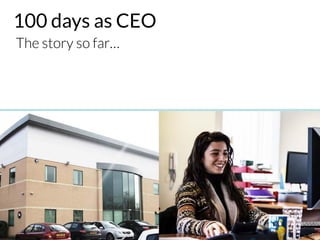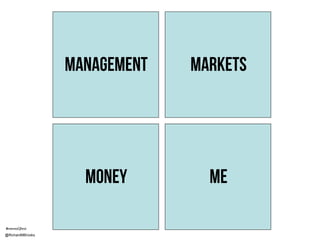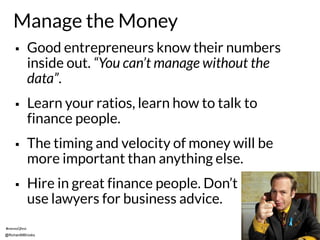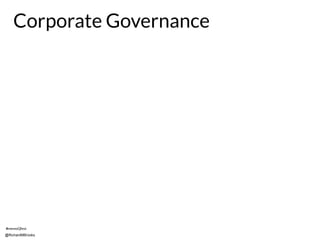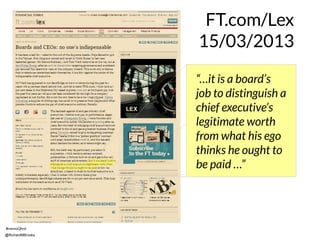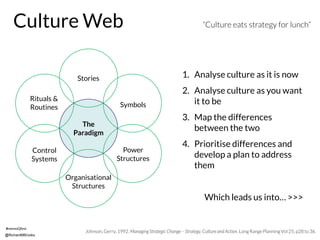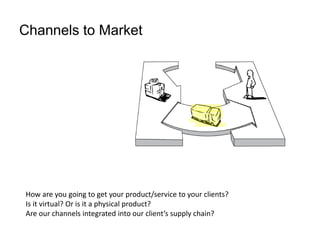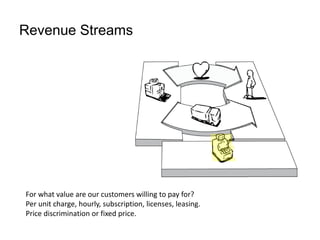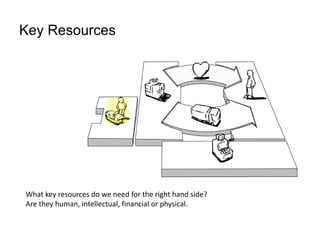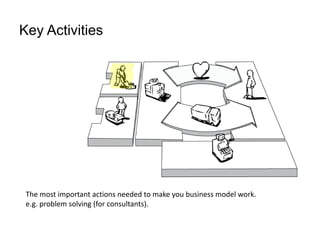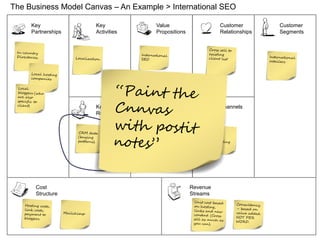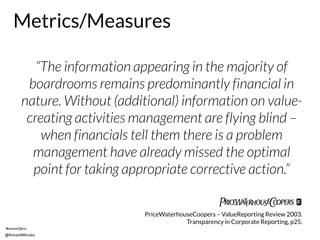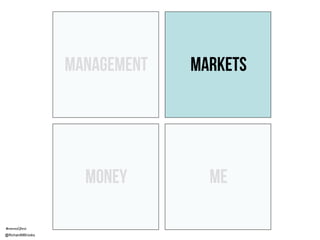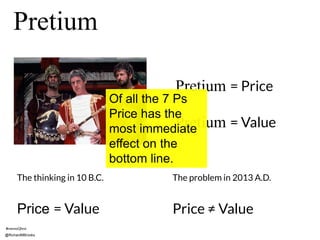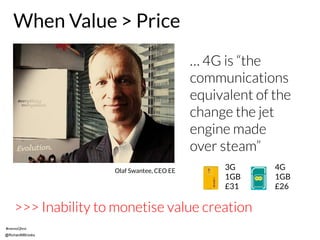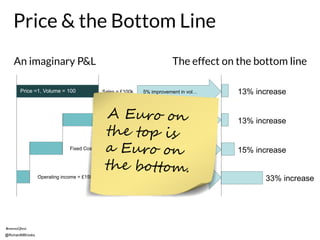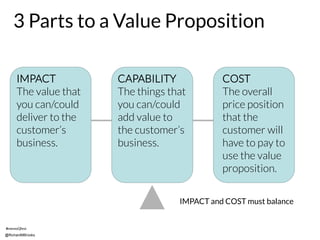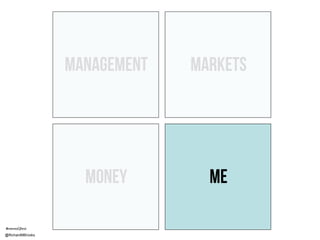100 Days as a CEO
- 1. Richard Brooks | memoQfest 2013 | Budapest #memoQfest @RichardMBrooks
- 2. #memoQfest @RichardMBrooks 100 days as CEO The story so far…
- 3. #memoQfest @RichardMBrooks Over 4 million registered companies in the UK* but very little academic research to help new CEOs. * Office for National Statistics, 2012
- 4. Months Changes Gabarro, John J., 1983. The Dynamics of Taking Charge (p. ). Boston MA: Harvard Business School Press.
- 5. Taking Hold Stage Immersion Stage Reshaping Stage Consolidation Stage Refinement Stage Time Since Succession Gabarro, John J., 1983. The Dynamics of Taking Charge (p. 20). Boston MA: Harvard Business School Press. Changes
- 7. #memoQfest @RichardMBrooks The bank has the deeds to MY house
- 8. #memoQfest @RichardMBrooks Manage the Money Good entrepreneurs know their numbers inside out. “You can’t manage without the data”. Learn your ratios, learn how to talk to finance people. The timing and velocity of money will be more important than anything else. Hire in great finance people. Don’t use lawyers for business advice.
- 10. #memoQfest @RichardMBrooks Management topics Corporate Governance Management into Leadership Culture Web Change Management Innovation Metrics
- 13. #memoQfest @RichardMBrooks “…it is a board’s job to distinguish a chief executive’s legitimate worth from what his ego thinks he ought to be paid …” FT.com/Lex 15/03/2013
- 14. #memoQfest @RichardMBrooks Management into Leadership Bennis, Warren, 1989. On Becoming a Leader. New York: Addison Wesley. Bennis’ list of differences • The manager administers; the leader innovates. • The manager is a copy; the leader is an original. • The manager maintains; the leader develops. • The manager focuses on systems and structure; the leader focuses on people. • The manager relies on control; the leader inspires trust. • The manager has a short-range view; the leader has a long- range perspective. • The manager asks how and when; the leader asks what and why. • The manager has his or her eye always on the bottom line; the leader’s eye is on the horizon. • The manager imitates; the leader originates. • The manager accepts the status quo; the leader challenges it. • The manager is the classic good soldier; the leader is his or her own person. • The manager does things right; the leader does the right thing. You can’t lead people until you understand yourself. Use EQ not IQ. “the task is to lead people. And the goal is to make productive the specific strengths and knowledge of every individual” – Peter Drucker
- 15. #memoQfest @RichardMBrooks Leadership Equation LQ = IQ + EQ + XQ
- 16. #memoQfest @RichardMBrooks Leadership Equation LQ = IQ x EQ x XQPotential
- 17. #memoQfest @RichardMBrooks Culture Web Stories Organisational Structures Power Structures Symbols Rituals & Routines Control Systems The Paradigm 1. Analyse culture as it is now 2. Analyse culture as you want it to be 3. Map the differences between the two 4. Prioritise differences and develop a plan to address them Which leads us into… >>> Johnson, Gerry, 1992. Managing Strategic Change – Strategy, Culture and Action. Long Range Planning Vol 25, p28 to 36. “Culture eats strategy for lunch”
- 18. #memoQfest @RichardMBrooks Change Management Adapted from Kotter JP. “Why Transformation Efforts Fail”, Harvard Business Review (March April 1995) p 61. 7. Keep going 8. Anchor new ApproachesImplementing & sustaining the change 1. Increase Urgency 2. Build Guiding Teams 3. Get the Vision Right Creating a climate for change 4. Communication for buy in 5. Enable Action/Empower Employees 6. Short term winsEngaging & enabling the organisation Want to know more? Talk to Stefan
- 19. #memoQfest @RichardMBrooks Innovation Osterwalder, Pigneur, Smith et al. “Business Model Generation”, Self Published, 2010. The Business Model Canvas Use it to model different scenarios in your business and disrupt your own business model (before someone else does).
- 20. Customer Segments Who is your customer? What market segments are you providing a service/product for?
- 21. What value do we deliver to your clients? or To your client’s supply chain? Is it based on > performance, brand, value, convenience, price… Value Propositions
- 22. Channels to Market How are you going to get your product/service to your clients? Is it virtual? Or is it a physical product? Are our channels integrated into our client’s supply chain?
- 23. Customer Relationships For each segment… what's the relationship like? Transactional, self-service, account/relationship managers, community.
- 24. Revenue Streams For what value are our customers willing to pay for? Per unit charge, hourly, subscription, licenses, leasing. Price discrimination or fixed price.
- 25. Key Resources What key resources do we need for the right hand side? Are they human, intellectual, financial or physical.
- 26. Key Activities The most important actions needed to make you business model work. e.g. problem solving (for consultants).
- 27. Key Partnerships Who do you need as your key partners. Used to optimise your business model, reduce risk or acquire resources.
- 28. Cost Structure Describes all costs involved in operating a business model. Is this business… cost driven, value driven, % of fixed and variable costs and are there economies of scale/scope?
- 29. Customer Segments Value Propositions Channels Customer Relationships Revenue Streams Cost Structure Key Resources Key Activities Key Partnerships The Business Model Canvas – An Example > International SEO
- 30. #memoQfest @RichardMBrooks Metrics/Measures “The information appearing in the majority of boardrooms remains predominantly financial in nature. Without (additional) information on value- creating activities management are flying blind – when financials tell them there is a problem management have already missed the optimal point for taking appropriate corrective action.” PriceWaterhouseCoopers – ValueReporting Review 2003. Transparency in Corporate Reporting, p25.
- 32. #memoQfest @RichardMBrooks Pretium Pretium = Price Pretium = Value The thinking in 10 B.C. Price = Value The problem in 2013 A.D. Price ≠ Value Of all the 7 Ps Price has the most immediate effect on the bottom line.
- 33. #memoQfest @RichardMBrooks When Value > Price … 4G is “the communications equivalent of the change the jet engine made over steam” >>> Inability to monetise value creation Olaf Swantee, CEO EE 3G 1GB £31 4G 1GB £26
- 34. #memoQfest @RichardMBrooks When Price > Value >>> lack of understanding of an emotive reaction to a small price change Becky Williams M&S Apology
- 35. #memoQfest @RichardMBrooks Price & the Bottom Line An imaginary P&L Sales = £100k Var Cost = £40k Fixed Cost = £45k Operating income = £15k The effect on the bottom line 5% improvement in vol… 5% improvement in price… 5% improvement in fixed cost… 5% improvement in var cost… Price =1, Volume = 100 33% increase 13% increase 13% increase 15% increase
- 36. #memoQfest @RichardMBrooks “the single most important decision in evaluating a business is pricing power” “if you’ve got the power to raise prices without losing business to a competitor, you’ve got a good business. And if you have a prayer session before raising the price by 10% you have a terrible business”
- 37. #memoQfest @RichardMBrooks Value Proposition A customer proposition is the unique mix of attributes that companies provide through their products, interactions, ethos and pricing to create loyalty and satisfaction in targeted customer segments. It is the unique set of benefits a business offers its target customers. - P Kotler
- 38. #memoQfest @RichardMBrooks 3 Parts to a Value Proposition Impact – How will you help the customer to succeed? Capability – What you have and what you can do for the customer. Cost – What the customer must pay to access the product/service. - N Rackham
- 39. #memoQfest @RichardMBrooks 3 Parts to a Value Proposition IMPACT The value that you can/could deliver to the customer’s business. CAPABILITY The things that you can/could add value to the customer’s business. COST The overall price position that the customer will have to pay to use the value proposition. IMPACT and COST must balance
- 40. #memoQfest @RichardMBrooks Price up or costs down Costs Down • Machine Translation • TMS • Translation memories • Volume • Off shore PMs Prices Up • Transcreation • Consultancy • Innovate your pricing model • DON’T commoditise your own product Finite amount of savings possible Only limited by your creativity
- 41. #memoQfest @RichardMBrooks Pricing case study • Popcorn. The butter costs more than the corn and the paper bag/cup it comes in costs more than both together.
- 42. #memoQfest @RichardMBrooks Brand P&G paid $57 Billion for Gillette (in 2005) but they only acquired $6 Billion of tangible assets*. What does a brand give you? • Better price • Higher sales • Lower prices • Better terms • More partners • Better retention • Lower salary expectations • Better qualified candidates • Higher PE ratio • Lower volitilty • Lower borrowing costs *David Haigh, Brand Finance, Marketing Magazine, 1st April 2005.
- 46. #memoQfest @RichardMBrooks Managing your timeImportance Urgency The Importance Vs Urgency Matrix HighLow Low High The first step is to list all the activities and projects that you feel you have to do. Try to include everything that takes up your time at work, however unimportant. (If you manage your time using a To-Do List or Action Program, you should have done this already.) Next, on a scale of 1 to 5, assign importance to each of the activities. Remember, this is a measure of how important the activity is in helping you meet your goals and objectives. Try not to worry about urgency at this stage. Once you've assigned an importance value to each activity, evaluate its urgency. As you do this, plot each item on the matrix according to the values that you've given it.
- 47. #memoQfest @RichardMBrooks 20% 40% 40% Working time spent in each box Weekend and evenings
- 49. Thank you! Have an awesome memoQfest 2013 I hope you make lots of new friends. Please tweet something profound #memoQfest / @RichardMBrooks Richard.Brooks@K-International.com


